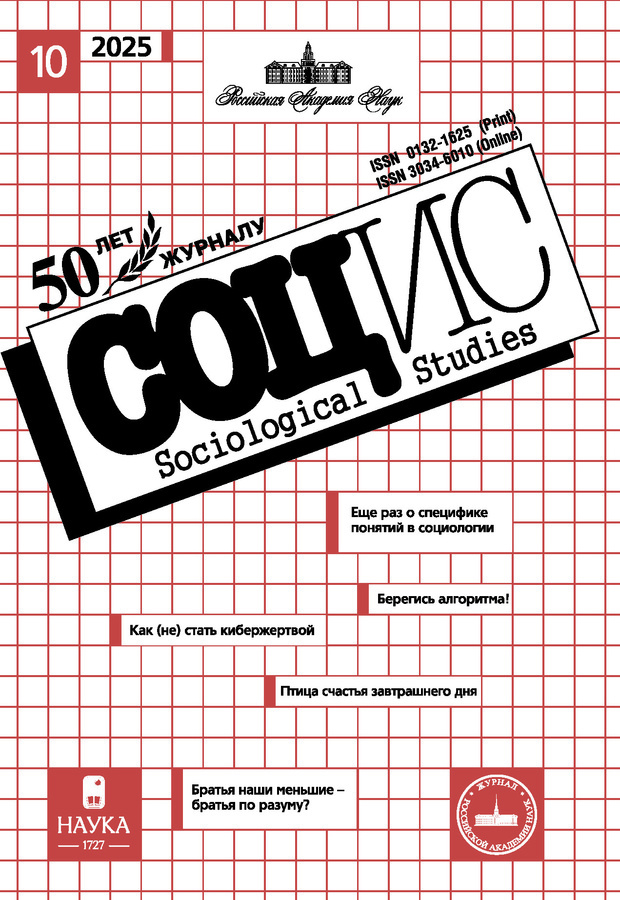Social Mobility and Urbanization in China and Russia: Opportunities and Constraints
- Authors: ZHANG J.1, LUO S.1, ZHANG D.1
-
Affiliations:
- Henan University of Animal Husbandry and Economy
- Issue: No 10 (2025)
- Pages: 162-167
- Section: FACTS. COMMENTS. NOTES
- URL: https://rjsocmed.com/0132-1625/article/view/696509
- DOI: https://doi.org/10.31857/S0132162525100148
- ID: 696509
Cite item
Abstract
The study explores the impact of urbanization on social mobility in China and Russia. The objects of the study were the cities of Beijing, Shanghai, Moscow, and St. Peterburg, which is determined by their representativeness. The methodology is based on an mixed-method approach that combines elements of descriptive statistical and sociological research, including quantitative surveys (N = 2000), and in-depth interviews with 20 respondents. The data obtained were processed and analyzed using the SPSS software tools, which made it possible to identify the mechanism of urbanization’s influence on social mobility. The findings reveal that while urbanization creates opportunities for professional development and access to education, it also reinforces social inequalities, particularly through housing costs and institutional barriers like China’s hukou system. Notable differences between the countries include the slower pace of urbanization in Russia compared to China’s infrastructure overload. These findings highlight the complex and multidimensional nature of urbanization’s impact on social mobility and suggest pathways for mitigating barriers and enhancing opportunities in urban environments.
Keywords
About the authors
J. ZHANG
Henan University of Animal Husbandry and Economy
Email: galya66888@mail.ru
Zhengzhou, Province Henan, China
S. LUO
Henan University of Animal Husbandry and Economy
Email: luoyunjie2016@mail.ru
Zhengzhou, Province Henan, China
D. ZHANG
Henan University of Animal Husbandry and Economy
Email: 115446484@qq.com
Zhengzhou, Province Henan, China
References
- Вартанова М.Л. Специфика урбанизации в России: ведущие факторы социального развития городской и сельской местности // Вестник Академии знаний. 2021. № 4(45). С. 61–71. doi: 10.24412/2304-6139-2021-11333. [Vartanova M.L. (2021) The Specifics of Urbanization in Russia: Key Factors of Social Development of Urban and Rural Areas. Vestnik Akademii znanii [Bulletin of the Academy of Knowledge]. No. 4(45): 61–71. (In Russ.)]
- Горожане в деревне. Социологические исследования в российской глубинке: Дезорганизация и сельско-городские сообщества / Под науч. ред. В.И. Ильина, Н.Е. Покровского. М.: Универ. книга, 2016. [Townspeople in the Village. Sociological Studies in Rural Russia: Disorganization and Rural-Urban Communities. (2016) Ed. by V.I. Ilyin, N.E. Pokrovskii. Moscow: Univer. kniga. (In Russ.)]
- Макшанчикова А.Ю., Попов Д.С., Никишин Е.А. Внегородские локальности: гибридизация «сельского» и «городского» в процессе миграции горожан в сельскую местность // Социологические исследования. 2019. № 12. С. 61–70. doi: 10.31857/S013216250007751-9. [Makshanchikova A.Yu., Popov D.S., Nikishin E.A. (2019) Non-Urban Localities: Hybridization of the “Rural” and “Urban” in the Migration of City Dwellers to the Countryside. Sotsiologicheskie issledovaniya [Sociological Studies]. No. 12: 61–70. (In Russ.)]
- Нефедова Т.Г., Покровский Н.Е., Трейвиш А.И. Урбанизация, дезорганизация и сельско-городские сообщества в условиях роста горизонтальной мобильности // Социологические исследования. 2015. № 12. С. 60–69. [Nefedova T.G., Pokrovskii N.E., Treivish A.I. (2015) Urbanization, Disorganization, and Rural-Urban Communities under the Conditions of Growing Horizontal Mobility. Sotsiologicheskie issledovaniya [Sociological Studies]. No. 12: 60–69. (In Russ.)]
- Черныш М.Ф. Концепт социальной мобильности в меняющихся обществах // Социологические исследования. 2018. № 7. С. 13–23. doi: 10.31857/S013216250000194-6. [Chernysh M.F. (2018) The Concept of Social Mobility in Changing Societies. Sotsiologicheskie issledovaniya [Sociological Studies]. No. 7: 13–23. (In Russ.)]
- Chan K.W. (2008) Internal Labour Migration in China: Trends, Geographical Distribution and Policies. URL: https://www.un.org/en/development/desa/population/events/pdf/expert/13/P05_Chan.pdf.
- Davis M. (2006) Planet of Slums. London, New York: Verso.
- Fawcett J.T., Khoo S.E., Smith P.C. (2019) Urbanization, Migration and the Status of Women. In: Women in the Cities of Asia. Routledge.
- Granovetter M.S. (1973) The Strength of Weak Ties. American Journal of Sociology. No. 6(78): 1360–1380.
- Kuddus M.A., Tynan E., McBryde E. (2020) Urbanization: A Problem for the Rich and the Poor? Public Health Rev. Vol. 41. No. 1. doi: 10.1186/s40985-019-0116-0.
- Li Y. (2021) Social Mobility in China: A Case Study of Social Mobility Research in the Global South. In: Social Mobility in Developing Countries: Concepts, Methods, and Determinants. Ed. by V. Iversen, A. Krishna, K. Sen. Oxford. Online ed. Oxford Academic. doi: 10.1093/oso/9780192896858.003.0010.
- Lin G.C.S. (2002) The Grows and Structural Change of Chinese Cities: a Contextual and Geographic Analysis. Cities. 2002. Vol. 19. No. 5: 299–316.
- Rains E., Krishna A. (2021) Informalities, Volatility and Precarious Social Mobility in Urban Slums. In: Social Mobility in Developing Countries: Concepts, Methods and Determinants. Ed. by V. Iversen, A. Krishna, K. Sen. Oxford. Online ed. Oxford Academic. doi: 10.1093/oso/9780192896858.003.0014.
Supplementary files











